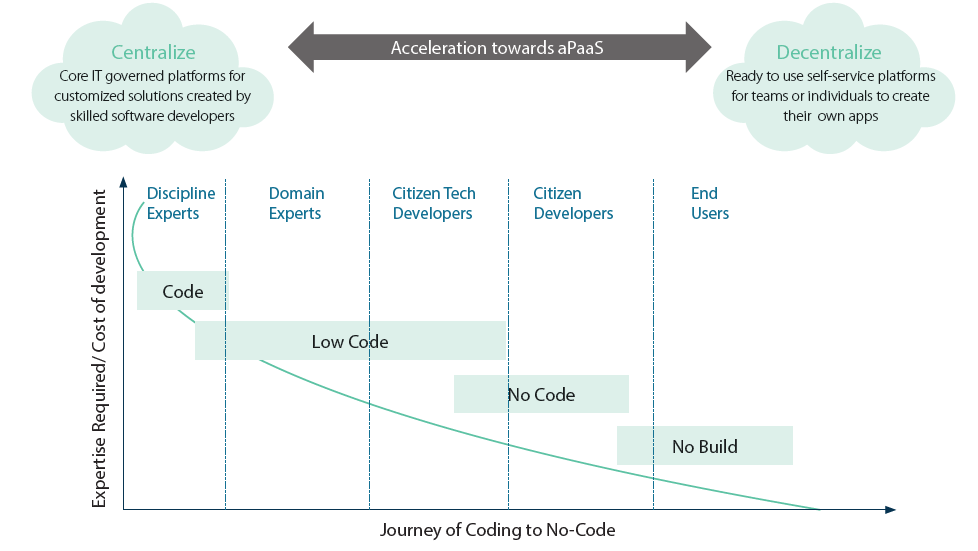
“Low Code No Code” (LCNC), is reshaping the way how software is being developed these days. One of the primary reasons being – the accelerated need for digital transformation which has further pushed LCNC into high gear. This need for going digital coupled with LCNC’s ability to deliver new capabilities with lower dependence on developers, makes it well positioned to witness significant growth amidst the current technology talent shortage that has become a global challenge.
So, what’s accelerating LCNC adoption? Principally, the constant pressure to innovate and solve problems faster than ever before is one important reason. Digitization requires two seemingly disparate sets of people: those who understand the business process, and those who understand how to implement the technology. Such a need is exactly why so many businesses are turning to LCNC for their automation needs.
Now while we discuss why people had to go for LCNC platforms, it is also important to understand how the software development process has transformed itself from a centralized hub to a decentralized self-service kind of an activity with the emergence of LCNC platforms today. This led to the democratization of software development over time. As you see through the journey below, the future is all about composing your own applications rather than hiring a skilled software developer to code for you.
DEMOCRATIZATION OF SOFTWARE DEVELOPMENT OVER TIME
In fact, Gartner states that “through 2022, the needs of business-driven (hyper)automation will be one of the top three drivers for low-code adoption.” Gartner has also projected low-code application platforms (LCAP) will be the largest component of the low-code development technology market through 2022. These platforms are predicted to account for more than 75% of app development, and this trend is likely to grow in near future.
Analysts suggest that one of the biggest trends for 2022 will have software developers using LCNC tools. A majority of developers think such tools will help save time, reduce overload, enhance productivity, and not render them obsolete. This in some way means developers are no longer defined by their proficiency in coding, but by their ability to integrate and build digital solutions that meets today’s business needs.
How does the LCNC ecosystem look like?
The LCNC movement has evolved into an ecosystem of partners, which includes platforms / tools creators, educators, evangelists, thought leaders, and entrepreneurs helping each other build / contribute to various needs.
What are the key drivers for LCNC adaption?
The following are some key aspects that renders LCNC adaption a good value proposition,
- There is an increasing need for cost effective digitization
- Increased need for process automation
- Businesses require omni channel tech solutions to aid changing customer needs
- Limited IT and Tech talent combined with Budget constraints
- High maintenance cost of existing custom build products
What is LCAP / NCAP?
There are variations how the platforms are referred to. Some call it Low Code/No Code application Platforms. Others refer it as Low Code/No Code Development Platforms. There are some significant differences in the capabilities these platforms offer, and often there is an overlap of features and a thin line to differentiate where you stand. For e.g., most of the No Code platforms also offer some capabilities for scripting and integrations which we term Low Code.
Despite the variations, some of the characteristics these platforms have in general are,
- Most of these platforms provide variety of visual tools to reduce / simplify the development effort to build an application.
- They also offer pre-built connectors, components, API’s and workflows that become the building blocks, thus enabling seamless integration across tools, products and platforms.
- They enable faster prototyping abilities, rapid development and deployment to production with minimal testing efforts. This helps in scaling the app/project and user base much easier than other solutions.
Who are the targeted users?
LCNC platforms offer a great advantage to both developers as well as business users.
Low-Code platforms lean towards improving the speed of developers, which are usually too complex for the common man / business user. If they try to make coding easy enough for anyone to use, then naturally it forces to limit the customization options / features. These platforms target to reduce the developers time and increase their productivity in comparison to traditional way of coding.
While the other type namely No-Code platforms are designed for business users to push for as little code as possible, where business users (aka Citizen Developers) can create applications. However, for complex scenarios, the citizen developer will need the help of an actual developer to create and deploy the functionalities they intend to automate.
How about sustainability in the long run?
Learning and Development plays a key role in the sustainability of the technology. These days customers expect anything and everything as of yesterday. LCNC tools are gaining traction among the developer communities just because of the short learning curve it requires. With the help of no-code communities and online learning platforms, it is possible for anyone to build a prototype or even a full version all by themselves in a few days.
It is said that approximately 70 percent of low-code users with no programming experience learn it within a month or even less, reflecting a low barrier to entry. A growing number of learning communities are offering courses in the LCNC space which provides a broader spread of information for non-technical users to get started.
Stay on…
There are some key inhibitors to highlight as well. Platform providers should increase focus towards unique customization requirements for the SMB segment to increase adaption. Lack of training on usage of LCNC solutions shall become an inhibitor to adoption if not handled appropriately by newer entrants. Also, reluctance from decision makers to migrate from Legacy to LCNC can be a challenge to overcome.
How does the future look like?
The ecosystem of LCNC will continue to expand with new & niche players, new capabilities and custom solutions. Secondly the adaption rates of LCNC tools by businesses of all sizes are equally rising and shall continue to rise. Even the SMB sector benefits to a great extent to expand their digitization and automation capabilities with minimum investment. As a result, the LCNC movement will likely continue to grow for the next decade or so.
NASSCOM says India has the Potential to Become a $4 Bn LCNC Market with a Higher Global Market Share by 2025.
Hope this article was useful and informative. Do you think LCNC will change the way we develop software traditionally? As more and more Business Users become app developers, do you think the core software developer’s community would get impacted? Please do leave your comments below.
Thanks for Reading. Stay tuned!

Look forward to connecting with you!
Finally, “subscribe” to my newsletter, so that you get notified every time when I publish.
– Murukesh Jayaraj
#Low-Code #No-Code #LCNC #lowcodenocode #LCAP #NCAP #LowCode #NoCode




